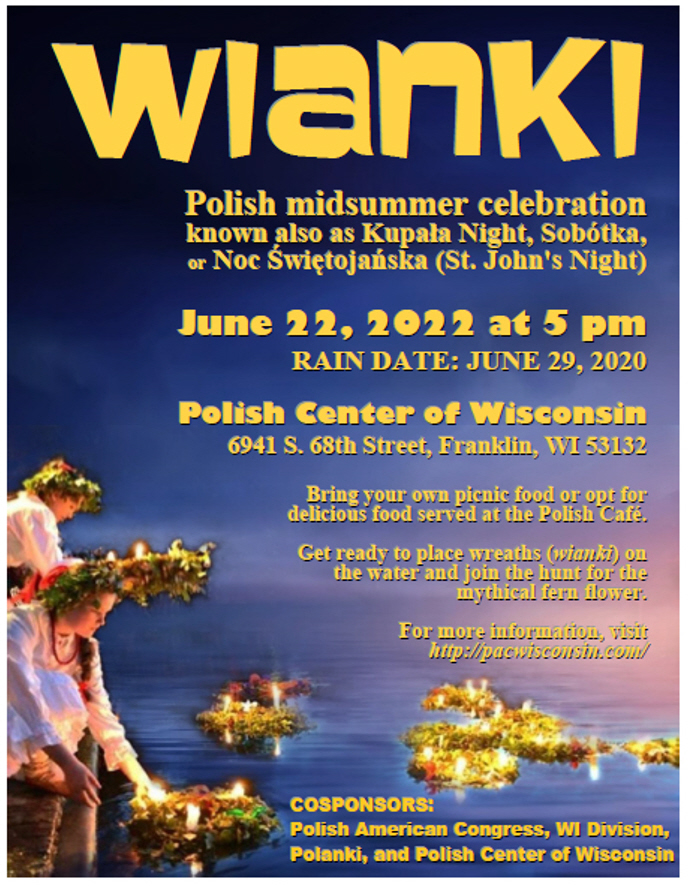░D░o░░y░o░u░ ░k░n░o░w░
░P░O░L░A░N░D░?░
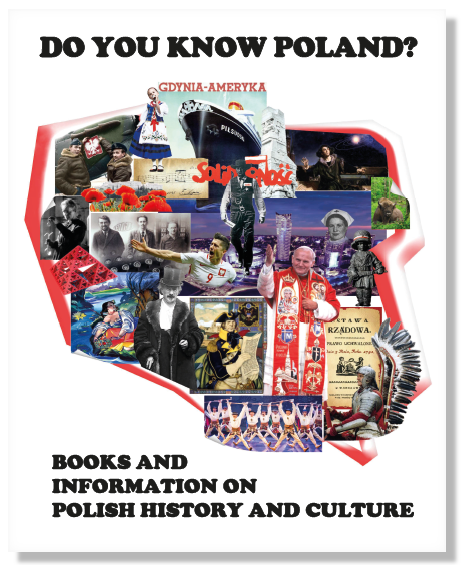
To download the booklet, click on the image above or on the red text below
► download the booklet here ◄
From the Polish American Congress WI Division website:
DYKP Contest Winners
“If you don’t know history, then you don’t know anything. You are a leaf that doesn’t know it’s part of a tree.”
Michael Crichton
This quote began the DYKP contest announcement on our website and in the national PAC newsletter. The contest challenged all to test their knowledge of Polish heritage by identifying images on the new cover of the “Do You Know Poland?” booklet. Now the joyous time has come to declare the winners and they are:
RALPH TYKSINSKI
Polish Heritage Club of Wisconsin-Madison
ANN KOCHANOWSKI
Polish American Congress - WI Division
Polish Heritage Awareness Society in Stevens Point
Congratulations to Ralph and Ann, for their incredible knowledge of Poland, it’s history and heritage - as well as the gusto with which they rose to the challenge.
We hope that DO YOU KNOW POLAND? booklet will inspire many others to use the resources it contains to begin or continue their pursuit of discovery, learning and appreciation for Poland and its people. In either case, a good starting point is a walk through map images as described below by line-heightthe map designer, Irena Frączek.
► download the description in PDF format here ◄
1. Pilots of No. 306 Polish Fighter Squadron "Torunian" (pl: 306 Dywizjon Myśliwski "Toruński"), one of over a dozen Polish squadrons in the Royal Air Force (RAF) during the WWII. Flight Lieutenants Tadeusz Czerwiński and Stanisław Skalski are photographed with Polish emblem in Churchstanton, Somerset, UK. on January 26-28, 1942.
2. A girl in the Kashubian folk costume photographed during the Polish Fest in Milwaukee. Kashubians (an indigenous Slavic population) live near the Baltic Sea in the eastern part of Pomerania. Kashubian dialect is related to Polish but classified as a distinct language. Almost 90% of Kashubians see themselves as simultaneously Kashubian and Polish.
3. Rare autograph of Frédéric Chopin (1810-1849) against a few measures of his widely known Polonaise in A-flat Major "Heroique" Op. 53. A musical celebrity and symbol of the Romantic era, his compositions are permeated with influences from Polish folk music and remain as popular around the world as ever. Polonaise (pl. polonez) is a national dance of Poland.
4. Named after Marshal Józef Piłsudski, the ocean liner MS Piłsudski (an older sister ship to the famous MS Batory) was a tribute to the country's leader and his role in the long struggle for Poland's independence regained in 1918. The ship's home port in Gdynia embodies the achievements and entrepreneurial spirit of the II Polish Republic, while service on the transatlantic route evokes numerous Polish-American connections.
5. The Westerplatte Monument (officially named the Monument to the Defenders of the Coast) commemorates the first battle of WWII that came to symbolize the war outbreak and the heroic Polish resistance against the Nazi Germany. In this battle, lasting for seven days, about 200 Polish soldiers bravely withheld attacks of 3,400 German forces supported by a battleship, torpedo boats and military aircrafts.
6. A true Renaissance man, Nicolaus Copernicus (pl. Mikołaj Kopernik) placed sun in the center of his heliocentric model of the universe. His book ‘On the Revolutions of the Heavenly Spheres’ triggered the Copernican Revolution that gave rise to modern science. Jan Matejko, a painter known for capturing the most profound moments of Polish history, created the painting "Astronomer Copernicus, or Conversations with God" adopted on the map..
7. The Białowieża Forest is the second oldest of 23 Polish national parks, and the only UNESCO-designated natural World Heritage site in Poland. It protects the last remnant of Europe's primeval forests and the largest population of European bison (pl: żubr). Polish kings started to protect the European bison already in the 16th century, but by the 20th century, the species had to be brought back from near extinction by conservation efforts.
8. Skyline of Warsaw, Poland with a good view on the city's seventh tallest building (630 feet, 192 m) - a luxury residential skyscraper located at Złota 44 and nicknamed the "Glass Sail."
9. Irene Sendler was a nurse and social worker who with help of her underground network and at great personal danger rescued about 2,5000 Jewish children from the Warsaw Ghetto. In October 1943, she became a head of children's section of Żegota (the Polish Council to Aid Jews, pl. Rada Pomocy Żydom), the only organization in German-occupied Europe that was established specifically to save Jews. Her wartime activities brought Irene Sendler numerous awards and Yad Vashem's recognition as the "Righteous Among the Nations."
10.The Little Insurrectionist (pl. Mały Powstaniec) monument in Warsaw commemorates the youngest fighters of the Warsaw Uprising (August 1 - October 2, 1944), the single largest military effort taken by any European resistance movement during World War II.
11. A very progressive for its time, the Polish Constitution of May 3, 1791 was the first modern written constitution in Europe, and only the second in the world after the Constitution of the United States. It remained in effect for just one year, becoming later a cherished national symbol that helped to keep alive the aspirations for Poland's independence and social justice.
12.The winged hussars, also called the Polish hussars, were the elite branch of heavy cavalry in the Polish–Lithuanian Commonwealth from the 1570s until 1776. Using a tactic of charge at and through the enemy, they won numerous battles - even against the overwhelming odds. They won some of the most important battles in the history of Poland (the Battle of Chocim, 1673) and Europe (the Battle of Vienna, 1683).
13. "Zbójnicki," a traditional dance of Gorals (pl. górale), highlanders from the mountainous Podhale region in Southern Poland, performed by Śląsk Song and Dance Ensemble..
14. Pope John Paul II during his first papal visit to Poland in 1979. The red stole was a gift from the Pauline Friars taking care of the Jasna Góra Monastery, one of the most important Marian shrines in the world. The painting of Black Madonna held in the monastery and portrayed on the stole has been an important part of Poland's history for over six hundred years.
15.Tadeusz Kościuszko is the national hero of the United States (the Revolutionary War), Poland and Lithuania. The 1938 painting by Arthur Szyk recalls Kosciuszko's legacy as defender of freedom, justice and equality for all. It also revisits his unfulfilled wish for Thomas Jefferson to execute his last will stipulating the use of all Kosciuszko's assets to buy out black slaves and provide them with education needed to make a fresh start in life..
16. Ignacy Jan Paderewski was a virtuoso pianists and composer admired in concert halls all over the world. He used his fame to advance the cause of restoring Poland's independence - especially when having an ear of the US President Woodrow Wilson. The power of his word was so great that the victorious Greater Poland uprising (1918–1919) broke out just one day after his patriotic speech in Poznań. What a joy it must have been for him to place his signature on the Versailles Treaty recognizing the Poland's hard-won independence in 1918..
17. Most people have seen Zofia Stryjeńska's art but not many know her name. Yet she earned the title of the "princess of Polish art" in interwar Poland (and fame in Europe) for her art deco designs and effervescent images. Her work revolved around pagan rituals, pre-Christian Slavic deities, historic themes, as well as Polish folk costumes, dances & traditions - just like the Polish custom of floating wreaths and candles on St. John’s Eve (pl. Noc Świętojańska). Zofia Stryjeńska was among the artists invited to work on the MS Piłsudski interior design.
18. Sierpiński triangle became my choice of an eye catching and hard to forget symbol of the astounding achievements of the Polish School of Mathematics to put on the map. Growing rapidly in the interwar period, its three branches bloomed simultaneously in Warsaw, Lwów and Kraków. Interestingly enough, Wacław Sierpiński applied his math genius to breaking Soviet codes, thus contributing to Poland's victory in the Polish-Soviet war (1919-21).
19. Another triumph of Polish cryptologists came when Marian Rejewski, Henryk Zygalski, and Jerzy Różycki developed a method for breaking German codes generated by the Enigma machine in December 1932. After Poles disclosed their secrets to the Allies in 1939, British code-breakers gradually started deciphering German communications. But only after Poland joined NATO in 1999, they began acknowledge the Polish role in those successes.
20. One of the greatest scientists of all times, Marie Skłodowska Curie, she developed the theory of radioactivity and discovered new elements: polonium (named after Poland) and radium. Despite multiple barriers on her path (poverty, misogyny and xenophobia), she became the first women ever to win a Nobel Prize, the first person to win it twice and the first in two separate disciplines (Physics in 1903 and Chemistry in 1911).
21. Red poppy might be a national flower of Poland but on this map, it represent the blood of Polish soldiers shed on the slopes of Monte Cassino in one of the fiercest battles of WWII. The Polish II Corps ended it launching one of the final assaults in the four month long struggle. On May 18, 1944, Polish flag was raised over the ruins of Monte Cassino Abbey (seen on the map behind the poppies), followed by the British Union Jack. "The Red Poppies on Monte Cassino" (pl. Czerwone maki na Monte Cassino) is one of the best-known songs in Poland.
22. Straight from the 1952 film “High Noon," Gary Cooper walks in this poster with the Solidarity badge on his chest and a ballot in his right hand. Used to put the Solidarity movement on the map, the poster urged people to vote in the pivotal 1989 election. The result was a landslide victory for Solidarity and a major step in the collapse of communism.
23. Robert Lewandowski is a captain of the Polish National Soccer team and one of the best players in the Bundesliga history (where he plays for Bayern Munich). Widely considered to be one of the best strikers in the world, he recently won the 2020 Best FIFA Men's Player Award and the 2020 UEFA Men's Player of the Year Award. On March 22, 2021, Polish President Andrzej Duda awarded Lewandowski the Commander's Cross of the Order of Polonia Restituta for his professional achievements and promotion of Poland abroad.
Polish American Congress - WI Division, Polanki and Polish Heritage Alliance
cordially invite all to
WIANKI
Polish midsummer celebration
known also as Kupała Night, Sobótka,
or Noc Świętojańska (St. John's Night)
WHEN: June 22, 2022 at 5 pm
WHERE: The front lawn and pond at the
Polish Center of Wisconsin
6941 S. 68th Street, Franklin, WI 53132
Bring your family and/or friends and get ready to place flower wreaths (wianki) on the water and join the hunt for the mythical fern flower.
Make wianki on your own using the flowers and greenery from your garden or bring the silk flower wreaths bought at the Polish Fest or other Polish events. A very limited number of wianki will be available at the event.
Also, bring some candles to give a special glow to your wreath floating on the water. And for festive atmosphere, wear white dress/shirt or flaunt your beautiful Polish folk costume.
Hungry for Polish Food? The Polish Café will be open from 4pm to 8pm.
Here is what's on the menu for Wednesday, June 22
LAST MINUTE REMINDER from the POLISH CENTER OF WISCONSIN:
“Polish Pope, John Paul II, and his epochal 1979 pilgrimage to his homeland”
Lecture by NEAL PEASE
Professor Emeritus of History
University of Wisconsin-Milwaukee
May 10, 2022 at 6:30P.M
Pope John PaulII three pilgrimages to his homeland began on June 2 1979. The Pope visited Warsaw, Gniezno, Częstochowa, Cracow, Kawaria Zebrzydowska, Wadowice, Oświęcim, Nowy Targ and again Crakow.
In 1978, a much younger version of UWM History professor Neal Pease journeyed to Poland, along with his wife Ewa, to spend a year carrying out research for his doctoral dissertation. What he did not know was that the coming year would bring the election of the Polish pope, John Paul II, and his epochal 1979 pilgrimage to his homeland that is often described as the beginning of the end of Communist rule in eastern Europe. Join us as Professor Pease relates his memories of witnessing first hand those events that changed the history of Poland and the world.
POLISH CENTER OF WISCONSIN
6941 S 68th St, Franklin, WI 53132, USA
► Map of Location ◄
The PHC Book Club
The Book Club members read and discuss a variety of books
about Polish heritage and/or written by Polish authors.
Here is the list of books we have explored over the years.
THIRD MEETING: 7pm on September 6, 2022
click here for location and contact information
Karolina And The Torn Curtain:
A Zofia Turbotynska Mystery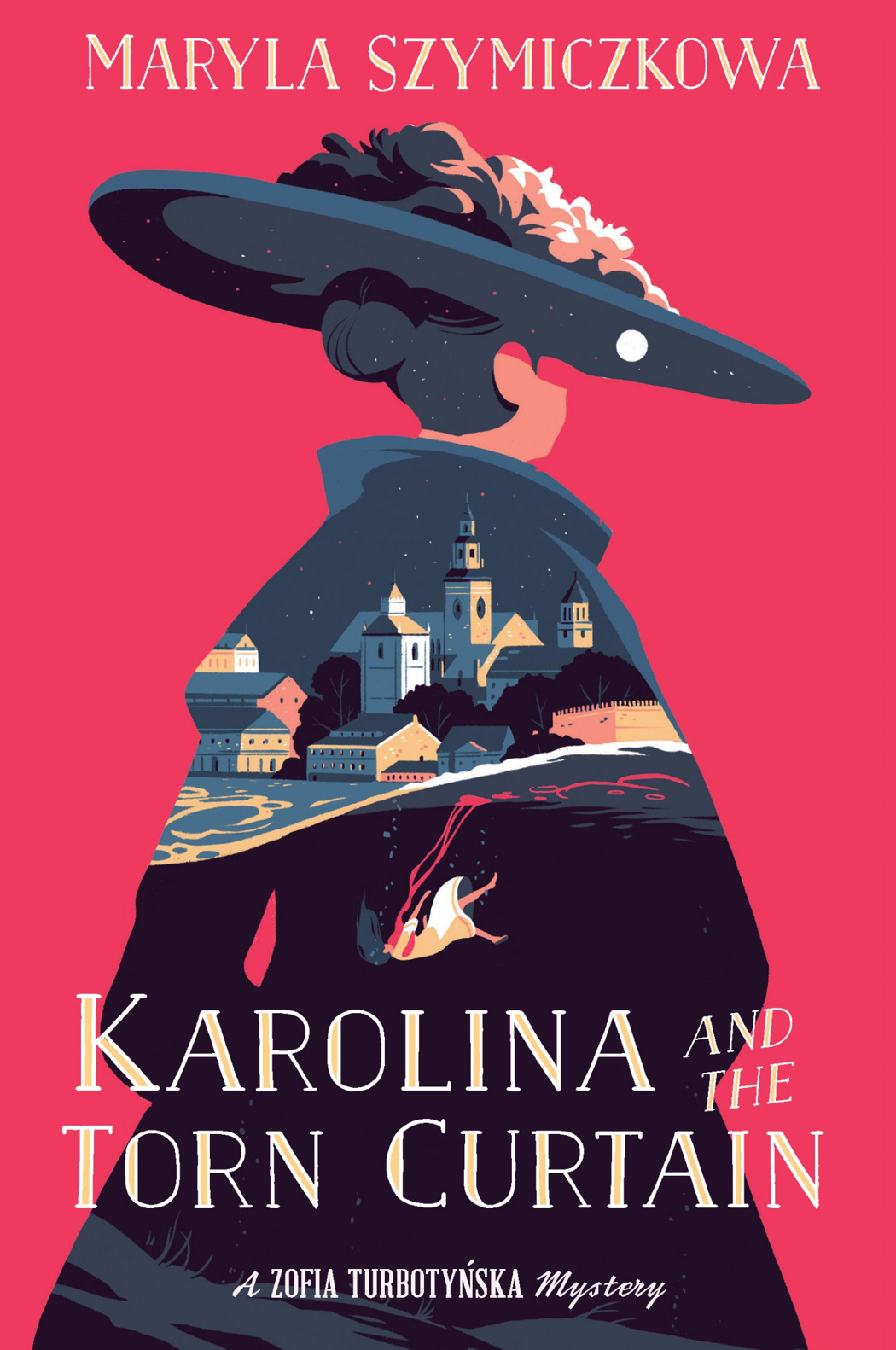
by Maryla Szymiczkowa
Polish title: Rozdarta zasłona.
Śledztwa profesorowej Szczupaczyńskiej
Translation by Antonia Lloyd-Jones
From the Amazon website: " “An ingenious marriage of comedy and crime” (Olga Tokarczuk, Nobel laureate): when amateur sleuth and cunning socialite Zofia Turbotyńska’s beloved maid goes missing, she dives deep into Cracow’s web of crime, with only her trusted cook for company."
From GoodReads: Set in Poland at about the time when some of my grandparents left and came to a Polish enclave in Wisconsin, the names and speech patterns are only too familiar. Many thanks to Antonia Lloyd-Jones for her translation of this fun mystery. I also thought it a marvelous thing to "see" Crakow as it once was instead of the disaster left by the last world war. Zofia is a rather snobbish wife of a professor who has a quick wit and an investigative bent. When one of her maids is found to have been murdered, her investigation (AKA snooping) brings her to the world of involuntary trafficking (which has yet to be eradicated in today's world)."
From the Kirkus Review: " Pseudonymous partners Jacek Dehnel and Piotr Tarczyński bring both the do-gooders and the criminals of fin-de-siècle Cracow to entertaining life, but their deepest interest is in the unlikely detective lurking beneath “the sedate Mrs. Jekyll”: “the hidden Mrs. Hyde, the fearless stalker of criminals.” .... A gravely decorous period piece that vividly evokes its moment while maintaining an archly amused distance from it."
From the Publisher's Weekly: "One night in 1895 Cracow, the body of 17-year-old housemaid Karolina Szulc is found on a river bank, in the pseudonymous Szymiczkowa’s entertaining sequel to 2020’s Mrs. Mohr Goes Missing. Karolina worked for Zofia Turbotynska, a respectable member of the bourgeoisie, who’s incensed by the police assuming the victim was a harlot, given the body’s location in a dubious district of the city. Keen to defend Karolina’s reputation, Zofia sets out to discover the truth. Her investigations put her in contact with every level of society, including prostitutes and socialists, and she even gets a glimpse of visiting Emperor Franz Joseph I of Austria."
From GoodReads: " Intriguing because of its sly take on the politics and society (high and low; the visible and the hidden aspects) just before the turn of the 20th century. Everything is slippery--values, mores, the justice system, and no character without some flaw (endearing or repellent)."
SECOND MEETING: 7pm on April 25, 2022
click here for location and contact information
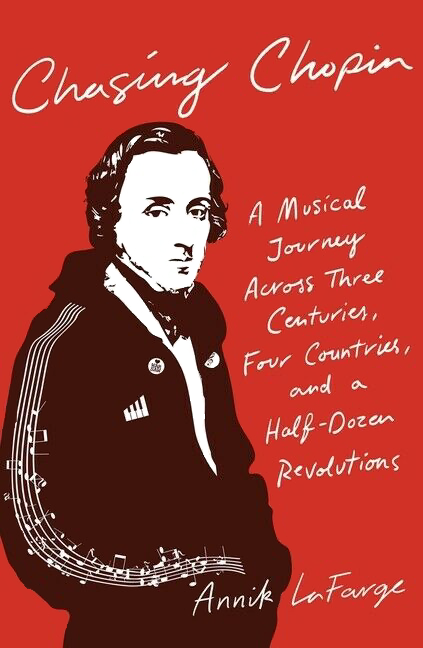
CHASING CHOPIN:
A Musical Journey Across Three Centuries,
Four Countries, and a Half-Dozen Revolutions
From the bookseller website: "The Frédéric Chopin Annik LaFarge presents here is not the melancholy, sickly, romantic figure so often portrayed. The artist she discovered is, instead, a purely independent spirit: an innovator who created a new musical language, an autodidact who became a spiritually generous, trailblazing teacher, a stalwart patriot during a time of revolution and exile.;
In Chasing Chopin she follows in his footsteps during the three years, 1837–1840, when he composed his iconic “Funeral March”—dum dum da dum—using its composition story to illuminate the key themes of his life: a deep attachment to his Polish homeland; his complex relationship with writer George Sand; their harrowing but consequential sojourn on Majorca; the rapidly developing technology of the piano, which enabled his unique tone and voice; social and political revolution in 1830s Paris; friendship with other artists, from the famous Eugène Delacroix to the lesser known, yet notorious in his time, Marquis de Custine. Each of these threads—musical, political, social, personal—is woven through the “Funeral March” in Chopin’s Opus 35 sonata, a melody so famous it’s known around the world even to people who know nothing about classical music. But it is not, as LaFarge discovered, the piece of music we think we know."
From the NYT review by Jeremy Denk (one of America's foremost pianists): "Looking back in time, LaFarge describes the composer’s loves and pianos (often the same); she explores his handwriting, his fingerings, his Polish identity. But she also turns to the present day, consulting aspiring pianists, authorities in historical performance and Zibi, the creator of the video game “Frederic: The Resurrection of Music.” For a book about death, it’s bursting with life and lively research. LaFarge writes passionately about Bach’s influence on Chopin, and the virtues of listening to period pianos to know what Chopin heard and imagined."
From the Kirkus Reviews: "A seamless blend of the musical and literary verve, with just enough research to ground and elucidate."
Chasing Chopin: A Music Site
Its content available for download in this pdf file
FIRST MEETING: 7pm on January 25, 2022
click here for location and contact information
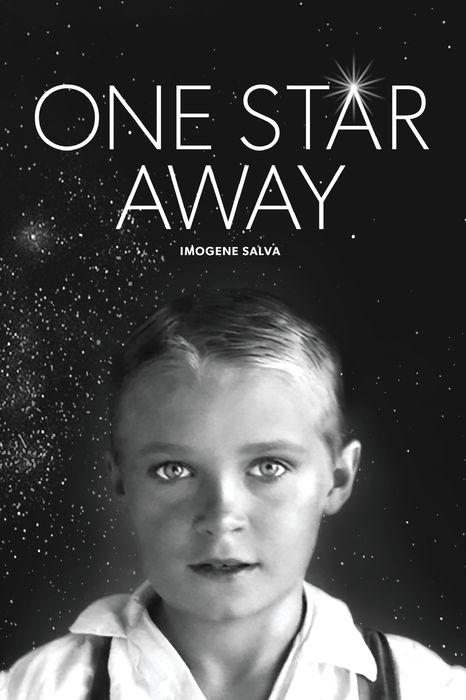
The author will attend the meeting
From the book's back cover: "In One Star Away, Imogene Salva re-constructs the emotional climate which surrounded the wartime ordeals of her mother, Józefa Nowicka, who was one of almost two million Polish citizens deported by Stalin's security police into the depths of Soviet Russia, Siberia and Central Asia. / by Norman Davies, author of "Europe: A History and Heart of Europe: The Past in Poland's Present"/
From the Amazon customer review: "World War II began with the German army invasion of Poland on 9/1/1939, followed by the Russian army invading eastern Poland on 9/17/1939. On February 10, 1940 at 3 a.m., Russian soldiers surrounded, entered and ransacked the home of a Polish family, forcibly removing Ziuta at age 8 along with her parents, her two brothers and three sisters, deporting them by train to a forced labor camp in northern Russia. The Soviets deported 1.7 million Poles to such labor camps in early 1940 and in June 1941. The family survives the 3-week journey in a crowded railcar intended for cattle (with a toilet that was just a hole in the floor). ...This true story continues in amazing accounts of struggle, survival and the aid of total strangers, including the Shah of Iran, an India Maharaja, a Polish Red Cross doctor, an actress/countess, an India truck driver and the Polish Government in Exile."
From the Amazon customer review: "This biography of a Polish child is an important and a true testimony to the history and fate of the entire generation of Poles in World War II. This novel is also a tribute to the memory of millions of people who experienced immeasurable suffering and degradation in Soviet Land, furthermore it is a warning against communism and its destructive power against the dignity of a human being. “Ziuta had been told by Mama that the Communists would try to make her think like them, and that they could be charming like the serpent in the Garden of Eden, but like venomous snakes they could kill both soul and body”(Salva 48). I would recommend this book for younger generations to create awareness and to note that one should not take one's freedom and peace for granted."
From the GoodReads reviews: " It is a story that inspires and frightens. It was frightening to see how inhumanity can stem from herd mentality which blinds human beings to cruelty and evil toward other humans. In contrast, it is hopeful and inspiring to see how this family survived and retained their humanity with their love and faith and the kindness and courage of people, who were willing to take risks out of the goodness of their souls. It is a story of resiliency and humanity winning out over unthinkable odds."
Discussion questions and other materials can be found in this pdf file
FOURTH MEETING: 7pm on November 16, 2021
click here for location and contact information
THE PERFECT HORSE:
The Daring U.S. Mission to Rescue the Priceless Stallions Kidnapped by the Nazis 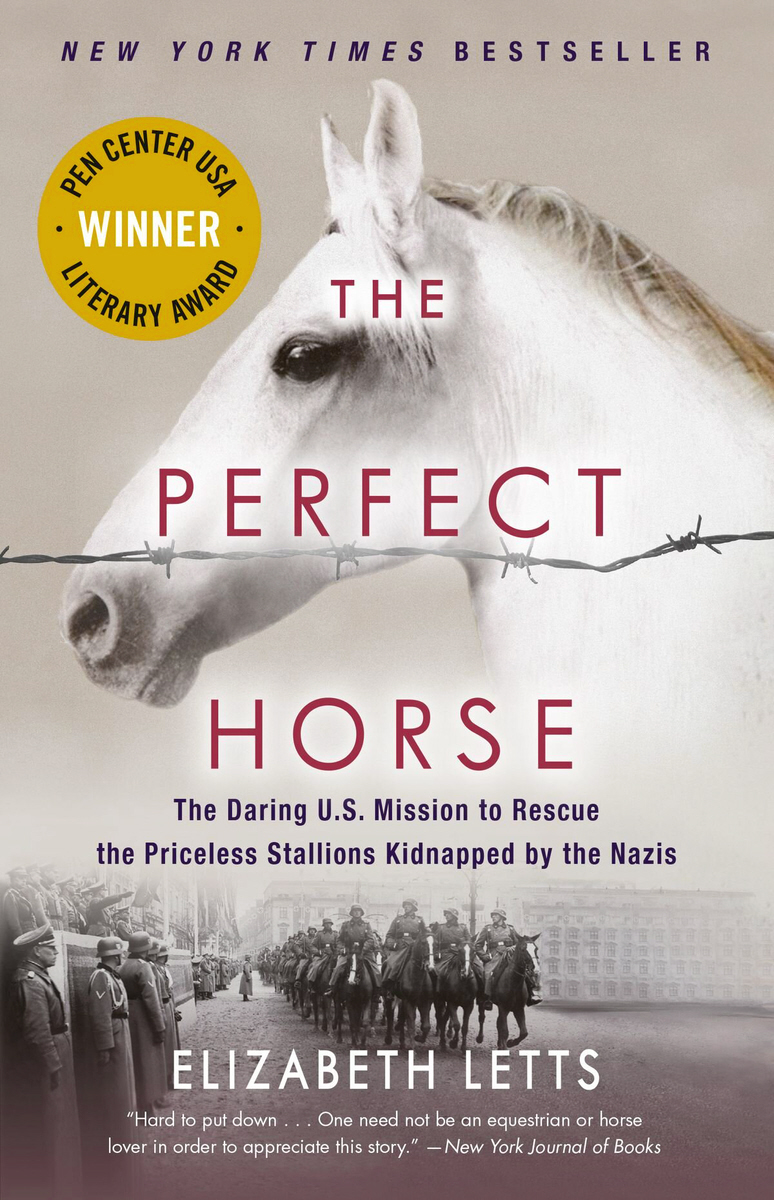
by Elizabeth Letts
From the Kirkus review: " Letts (The Eighty-Dollar Champion: Snowman, the Horse that Inspired a Nation, 2011, etc.), a lifelong equestrienne, eloquently brings together the many facets of this unlikely, poignant story underscoring the love and respect of man for horses. The horses in question were rare Arabian thoroughbreds introduced to Europe by the Ottoman Turks in the late 17th century and subsequently bred in Poland. The Bolsheviks had slaughtered nearly the whole stock in 1917, deeming them the “playthings of princes,” though the Polish stud stable at Janów Podlaski was finally beginning to thrive again by the time of the Russian-Nazi invasion of Poland in late 1938. Two important equine sagas, handled well by the author, converge here: the German takeover of the Janów stud farm, led by German Olympic organizer Gustav Rau, in order to reassemble the Polish horse-breeding industry for the glory of the Third Reich, which desperately needed horses for mounted troops; and the attempts to save the working Lipizzaner stallions at the aristocratic Spanish Riding School in Vienna, led by Alois Podhajsky, who had won the bronze medal in dressage at the 1936 Berlin Olympics. Under Rau, the stud farm was moved to Hostau, Czechoslovakia, by October 1942, and put under the care of Polish civil servant Hubert Rudofsky, who successfully increased the number of bred Lipizzaners by 1944. With Allied bombs falling on German cities, and eventually Vienna, Podhajsky determined that his horses had to be moved to safety, eventually housed in the village of St. Martin, Austria, yet the Nazi-controlled Austrian government was loathe to relinquish control of such a symbol of Austrian determination. Enter the Americans, specifically Maj. Hank Reed of the 2nd Calvary, which had traded in tanks for horses to fight the Nazis across France, and the exciting meeting of Gen. George Patton’s army at Hostau....The author’s elegant narrative conveys how the love for these amazing creatures transcends national animosities."
Discussion questions and other references can be found in this pdf file
Check also "Witez II: The Preservation of the Polish Arabian" by Elizabeth K Wal,
one of two winners of the 2020 PHCWi-Madison Scholarship.
To register and for more information, please sent an e-mail to
phcwinews@gmail.com
THIRD MEETING: 7pm on August 3, 2021
click here for location and contact information
Professor Wacław Szybalski on Lwów, Genes, the Essence of Life, and Nobel Laureates
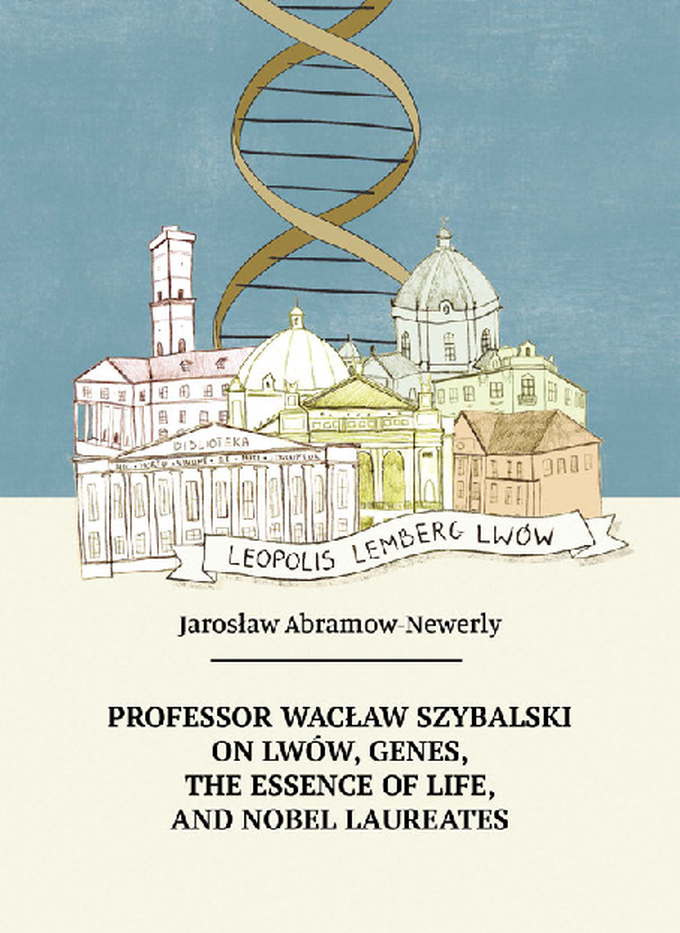
Jarosław Abramow-Newerly
Polish title:
Profesor Wacław Szybalski o Lwowie,
genach, istocie życia i noblistach
Many people have contributed to the publication of this book: its protagonist, Professor Wacław Szybalski, who has amazed us with his splendid memory and his concern for detail, both when describing people — members of his family and his many friends and colleagues in science — as well as places and events; Jarosław Abramow-Newerly and his wife Wanda, who conducted and recorded many interviews with members of the Professor's family and his friends; and Irena Frączek — the colleague and friend of Professor — who supplemented the recollections recorded by the book's author and supplied photographs and notes.
The idea of the book, which dates from 2010, and the proposal that Jarosław Abramow-Newerly write it, came from Dr. Jerzy Barankiewicz, founder and president of the Polish Arts Salon in San Diego. The Professor Wacław Szybalski Foundation undertook to publish the book, which describes the full life and enormous scientific achievements of one of the most outstanding Polish scientists. Professor Szybalski left Poland in 1949, but as a Pole and a citizen of Lwow he has always supported Polish science. For his services to science, he has received honorary doctorates from five Polish higher-educational institutions, and in 2011, the President of the Republic of Poland, Broniscław Komorowski, awarded him the Grand Cross of the Order of Polonia Restituta.
To register and for more information, please sent an e-mail to
phcwinews@gmail.com
SECOND MEETING: 7pm on April 14, 2021
click here for location and contact information
MRS. MOHR GOES MISSSING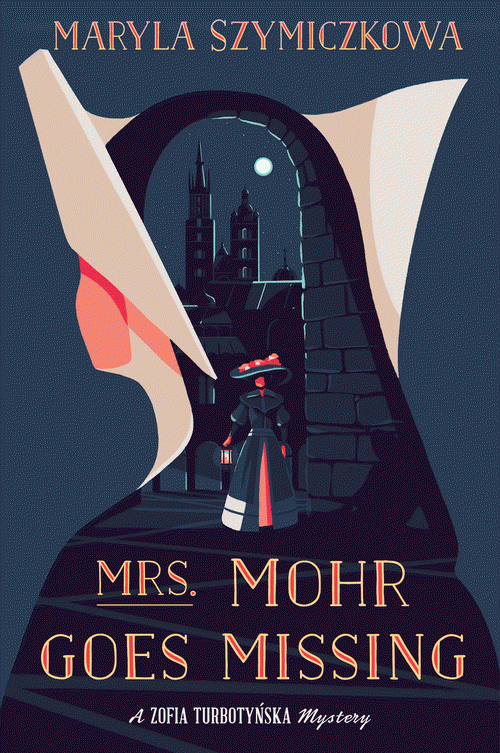
by Maryla Szymiczkowa
Polish title: Tajemnica domu Helclów
Translation by Antonia Lloyd-Jones
From the Publisher's Weekly: " Set in 1893 Cracow, this exceptional debut and series launch from Polish author Szymiczkowa (the pen name of writing duo Jacek Dehnel and Piotr Tarczynski) introduces Zofia Turbotynska, a 38-year-old professor’s wife, who finds household management, novel reading, and the search for social prestige insufficient outlets for her prodigious energy. At a nursing home run by nuns that she visits to promote a charitable cause, she becomes involved in the search for a missing resident, Antonina Mohr, a judge’s widow."
From GoodReads: "Drawing on Agatha Christie and filled with period character and charm, Mrs Mohr Goes Missing vividly recreates life in turn-of-the-century Poland, confronting a range of issues from class prejudice to women's rights, and proving that everyone is capable of finding their passion in life, however unlikely it may seem."
From Historical Society: "The tone of the book reminds me very much of the society fiction of E.F. Benson, with its wry and camp humour – Zofia is very like one of his social climbing hostesses and is a crashing snob. The topography and milieu of late 19th-century Cracow are depicted, as is Poland’s overall subordinate position within the ruling Viennese-based Hapsburgs. Towards the latter half of the story, the narrative is occasionally rather difficult to follow as all sorts of new threads and directions in the story open up, but Zofia does successfully bring them all together at the end in a traditional golden-age detection conclusion and unveiling of the culprit."
From the Crime Review:"The appearance of several real historical figures, whether in passing comments or in the background of events that occupy Zofia, adds to the authentic feel of what of course is the fictional atmosphere of Kraków at the time. I especially enjoyed the strong characterisation of the peculiar universe inhabited by diverse society. .... The intricacies of the Polish language and the flowery flowing narration, beautifully translated by Antonia Lloyd-Jones, will appeal to anyone who enjoys an ingenious mystery featuring a larger than ordinary restricted life heroine, and an evocative feel of a turn-of-the-century country which did not exist on the political map of Europe, yet managed to thrive through various artistic and cultural areas"
Check also this pdf file by Elizabeth K Wal - one of two winners of the 2020 PHCWi-Madison Scholarship.
To register and for more information, please sent an e-mail to
phcwinews@gmail.com
FIRST MEETING: 7pm on January 26, 2021
click here for location and contact information
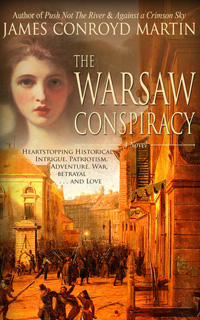
The author will attend the meeting
From GoodReads: " Engaging and opulent, THE WARSAW CONSPIRACY unfolds as a family saga set against the November Rising (1830-1831), partitioned Poland’s daring challenge to the Russian Empire."
From the Amazon website: "Brilliantly illustrating the psyche of a people determined to reclaim independence from Russia in the face of monumental odds, The Warsaw Conspiracy features two brothers and their fates in love and war. Michał is a seasoned veteran soldier, cautious of the evolving conspiracy; Józef, his much younger brother and impassioned cadet, finds himself caught up in the vortex of a daring plot to abduct the Grand Duke of Russia. With Siberia or emigration to France looming as heart-rending contingencies, matriarchs Anna and Zofia stay steadfast in their resolve to steer the clan through ever-muddying waters.."
From the Am-Pol Eagle: "....The novel also seamlessly blends the real lives of Chopin, Prince Adam Czartoryski (president of the Polish National Government during the November 1831 uprising against imperial Russia), and Grand Duke Konstantin Nikolayevich of Russia, among other notables...."
From the Cosmopolitan Review:"Poles and lovers of Central European history will recognize in this trilogy about the Stelnicki family the familiar story of Poland’s struggles against oppressive regimes, specifically the 1794 partition of Poland by Prussia, Austria and Russia (Push Not the River), the 1813 Napoleonic wars (with their implicit promise of freedom for Poland) (Beneath a Crimson Sky), and this volume, The Warsaw Conspiracy about the November Uprising of 1830 (the “cadets’ revolution”). Readers in Northern California might be interested to know that quite a number of Polish veterans of the 1830 Uprising found their way to San Francisco, among them Aleksander Zakrzewski (who drew the first plan of San Francisco), Rudolf Korwin Piotrowski (the prototype for Sienkiewicz’s Zagłoba), Feliks Paweł Wierzbicki (physician and publisher of the first book in English in California), Aleksander Bednawski (friend of Piotrowski), Jan Teofil Strencel (whose daughter married naturalist and preservationist, John Muir), engineer and surveyor Józef Truskolawski, and Kazimierz Bielawski (founder of the Polish Society of California)."
From the Bookshop website: "James Conroyd Martin is in every way a modern day Henryk Sienkiewicz, weaving history and stories together in an accessible and thrilling manner." Dr. Donald Pienkos, Political Science Professor Emeritas, UW Milwaukee."
To register and for more information, please sent an e-mail to
phcwinews@gmail.com
FIFTH MEETING: 7pm on November 10, 2020
click here for location and contact information
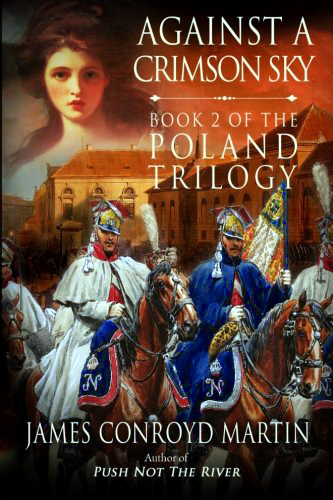
AGAINST A CRIMSON SKY
by James Conroyd Martin
From the Amazon website: "A magnificent epic... an unforgettable tale of love, valor, and the enduring strength of the human spirit, set against the backdrop of war-torn Poland at the cusp of the nineteenth century... The year is 1794, and the beautiful and resilient Countess Anna Maria Berezowska has narrowly escaped death amidst the chaos caused by the violent dissolution of Poland."
From the Publishers Weekly website: "....entertaining sequel that follows Anna through the chaotic years of the Napoleonic wars. These are trying times for her beloved Poland ("Europe's plaything")..."
From the author's website: "With Napoleon Bonaparte’s ill-fated campaign to conquer Russia as a backdrop, Against a Crimson Sky manages to turn the wily emperor’s exploitation of Polish patriotism into a classic read that lovers of Push Not the River will devour. James Conroyd Martin brings back the characters that made his first novel so compelling, deftly weaving their daily lives into the panorama of war and turmoil that consumed Poland in the early nineteenth century. What’s remarkable about Martin’s work is its authenticity, rooted in the actual diary of a Polish noblewoman. Martin creates a romantic canvas of epic proportions, bringing vividly to life seldom-invoked events in European history. He portrays a world of hardship and heart in marvelously rendered ‘little pieces of happiness stolen from a tapestry of turmoil, war, and separation.’” ~Leonard Kniffel, Editor-in-chief of American Libraries and author of A Polish Son in the Motherland: An American’s Journey Home "
From the Bookshop website: James Conroyd Martin is in every way a modern day Henryk Sienkiewicz, weaving history and stories together in an accessible and thrilling manner." Dr. Donald Pienkos, Political Science Professor Emeritas, UW Milwaukee."
FOURTH MEETING: 6:30pm on September 29, 2020
click here for location and contact information
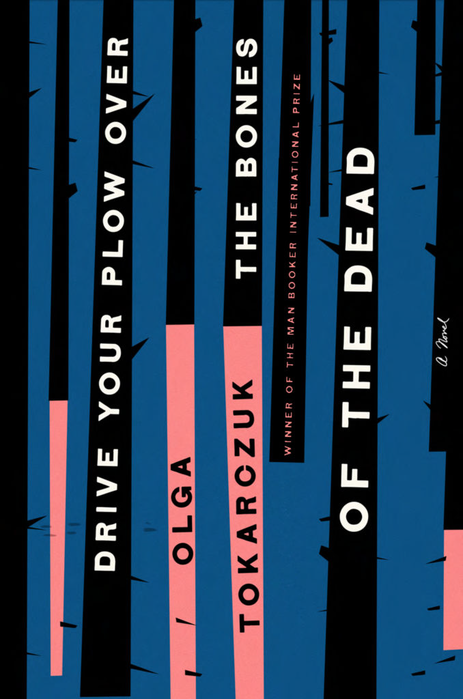
DRIVE YOUR PLOW OVER THE BONES OF THE DEAD
by Olga Tokarczuk
Polish title: Prowadź swój pług przez kości umarłych
Translation by Antonia Lloyd-Jones
From the Amazon website: "In a remote Polish village, Janina devotes the dark winter days to studying astrology, translating the poetry of William Blake, and taking care of the summer homes of wealthy Warsaw residents. Her reputation as a crank and a recluse is amplified by her not-so-secret preference for the company of animals over humans"
From the NPR review: "The friction generated between Janina and the hunters powers the entire narrative. When one hunter reassures an irate Janina that he and his friends are "simply" shooting pheasants, she feels "a surge of Anger, genuine, not to say Divine Anger ... For Janina, the killing of innocent creatures is murder, and even if you don't quite share the depths of her anger, you are likely to understand it. How could one not sympathize with a woman so thoroughly thwarted in protecting animal life?"
From the Amazon website: " A deeply satisfying thriller cum fairy tale, Drive Your Plow over the Bones of the Dead is a provocative exploration of the murky borderland between sanity and madness, justice and tradition, autonomy and fate. Whom do we deem sane? it asks. Who is worthy of a voice?"
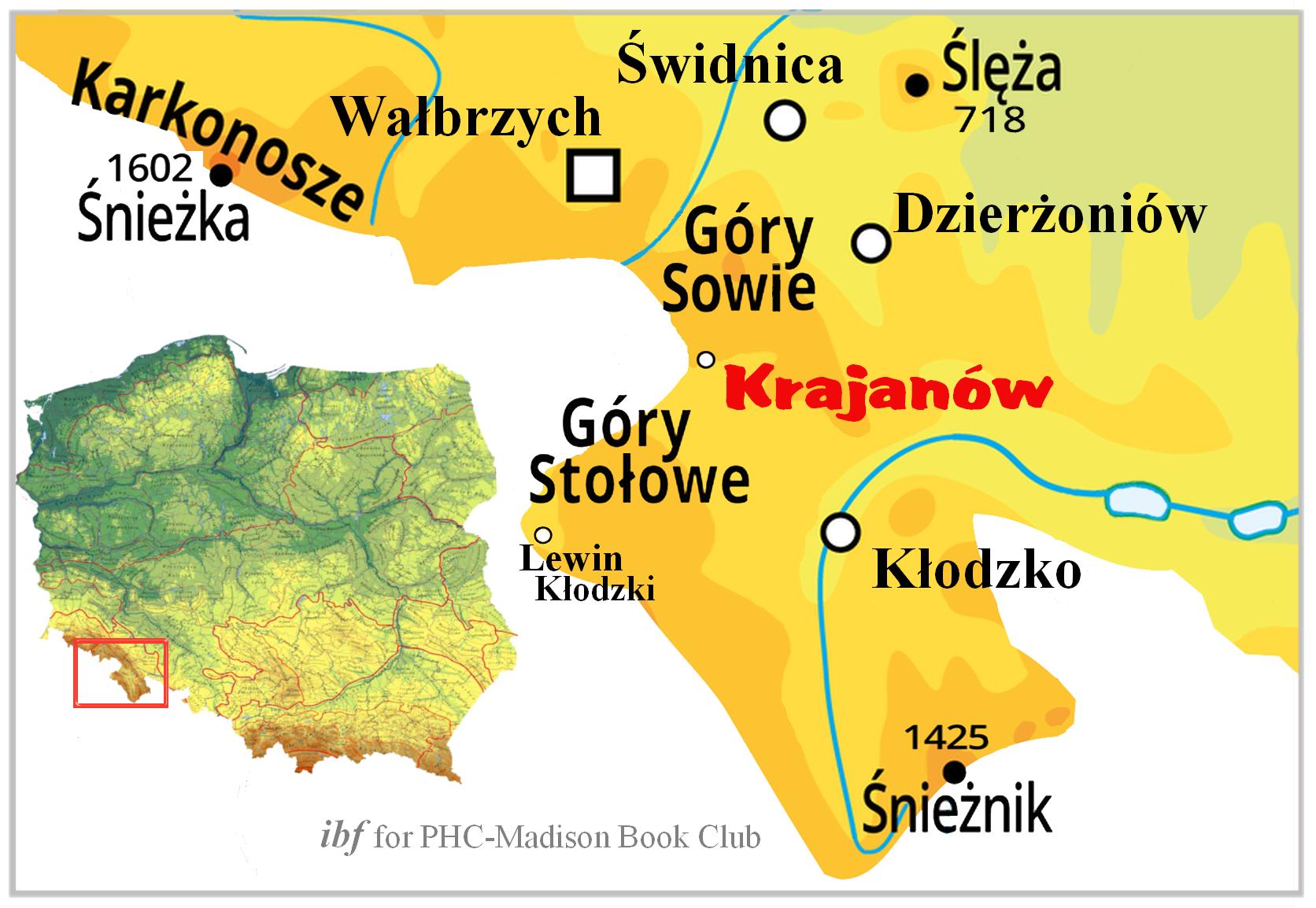
The story takes place in Kłodzko Land (Ziemia Kłodzka), a south-jutting part of the Lower Silesia (Dolny Śląsk). Janina resides in a village located between Kłodzko and Lewin Kłodzki. In this beatiful area, the Table Mountains (Góry Stołowe) rise statuesquely above the Kłodzko Valley (Kotlina Kłodzka). Not far away, Tokarczuk lives in Krajanów (Krajanów), a village at the foothills of the Owl Mountains (Góry Sowie).
Below: The view of Table Mountains via Wikimedia Commons.
From the NPR review: " And there is a polemic — or at least a lament — hidden in the subtext: Drive Your Plow Over the Bones of the Dead is a sort of ode to Blake (whose verse opens each chapter, and whose verse Janina translates — in one hysterical sequence, three different ways: "a complicated form of Scrabble"). Blake: the philosopher and poet so preoccupied the respecting the innocence of the natural world. And in tying Janina with Blake so closely, Tokarczuk manages to link Blake's sharp indictment of human encroachment into nature with Janina's horror at the hunting and killing of animals, and the creep of human corruption into the Polish wilderness"
From the LA Times book review: "Janina’s impassioned and polemical turning of the tables on industrialized farming — “concentration camps,” she calls them — feels overdone, and one wonders at her neglect of the vegan issue (i.e., the imprisonment of female animals to capture their secretions). Then again, this Polish novel cannot be blamed for falling a little flat in the Anglophone context, where the discourse around vegetarianism has shifted away from animal welfare toward concerns about the long-term survival of the planet."
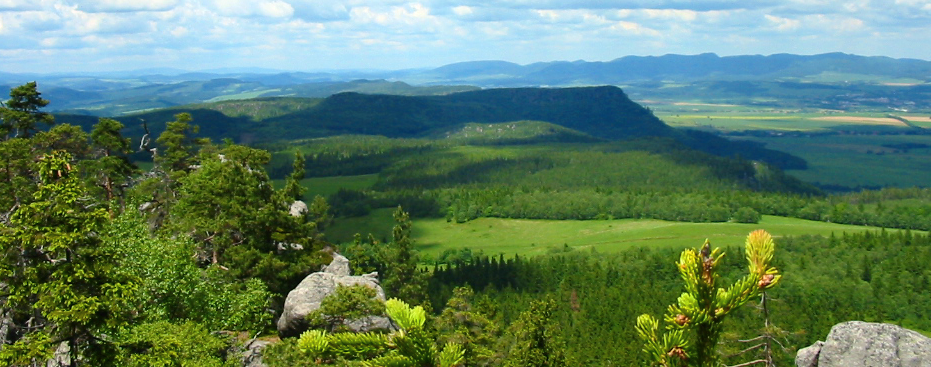
About SPOOR (pl. Pokot), a film based on Tokarczuk's book
(dir. Agnieszka Holland, 2017)
"Full of spectacular nature shots of deer and boar scampering through snowy virgin forests, the film could find art house audiences on the sheer beauty of its production. Animal rights groups might well embrace it as a landmark.... Well aimed, but ultimately off-target. " - The Hollywood Reporter
"Beautifully photographed and aurally matched by a magnificent score, Spoor is let down by its far-fetched premise of a woman who values animal welfare over the humanity of ‘evil’ men" - desistfilm
"The hunt is quite often the place where important political decisions are made. It’s like a boys’ club.....They can execute their power in a very direct way, by killing living creatures" - The Guardian
"... as far as mood, tone, and ambience, Spoor takes a progressive, liberal stance on animal rights and makes both sides so bleakly extremist it either provides its more gullible, non-questioning audience members with a clearly constructed diagram of who and what to cheer for, while others may be left merely with a cynical, bitter aftertaste from a narrative too quirky to take serious and too belabored to instill tension" - ioncinema
Visit Rotten Tomatoes for links to more reviews
THIRD MEETING: 7pm on July 21, 2020
click here for location and contact information
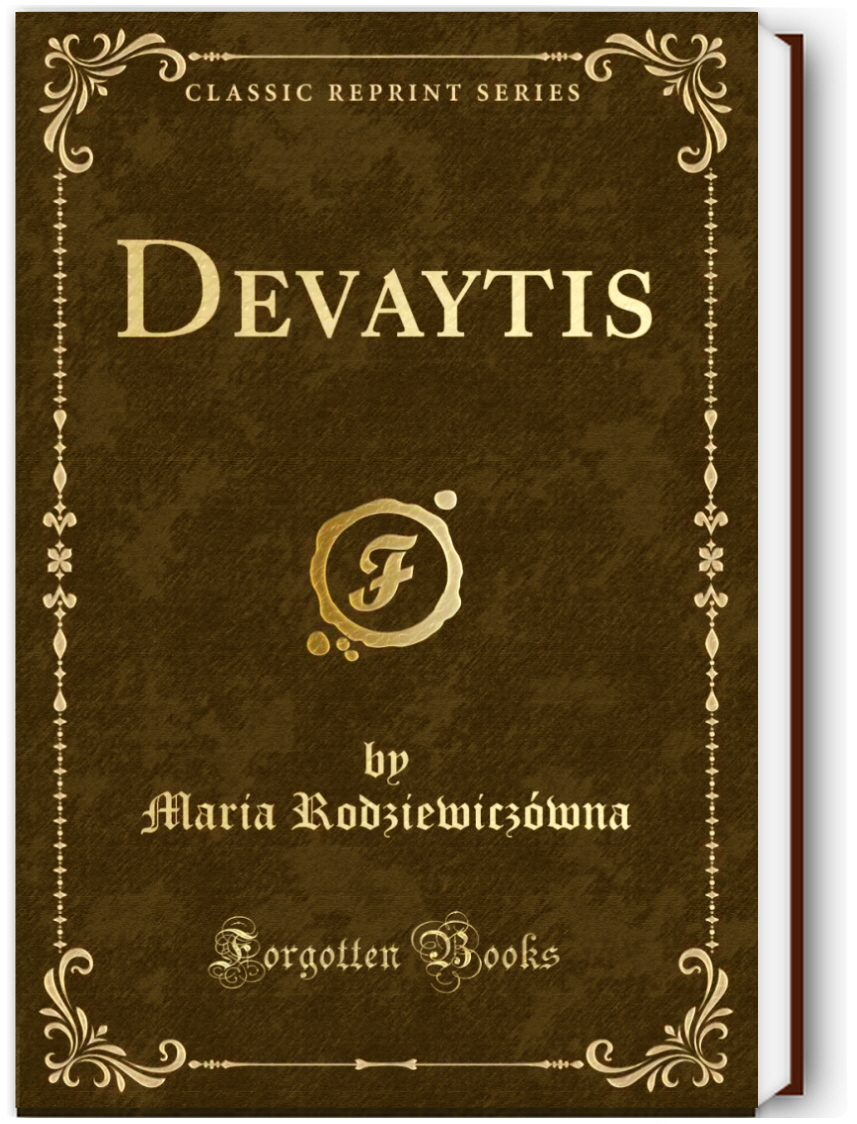
DEVAYTIS
Polish title: Dewajtis
<a style="color: #cc0909; font-size: 12pt;"
Page 1 of 3

